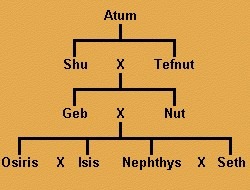
Die ägyptische Mythologie und ihre Myriaden von Gottheiten wurden von den Priestern selbst in einem gewissen Ausmaß geordnet. Das Ergebnis war die Erschaffung einer Reihe von Neunheiten, Gruppen von neun Göttern und Göttinnen, die gewöhnlich zu Familien angeordnet waren. Die Zahl neun war eine heilige und symbolische Zahl, die auch für 'alle' Götter stehen konnte. Das kam daher, weil die Ägypter den Plural durch die Verwendung der Drei anzeigten, und neun wurde deswegen als der Plural des Plurals begriffen. Darum sollte 'neun' nicht immer wörtlich genommen werden; die Neunheit von Theben beispielsweise, bestand aus fünfzehn Gottheiten. Die wichtigste Neunheit war diejenige von Heliopolis, die oft die Große Neunheit genannt wurde. An ihrer Spitze stand Atum, der Schöpfer- und Sonnengott. Seine Kinder Schu und Tefnut brachten den Erdgott Geb und die Himmelsgöttin Nut hervor, welche wiederum die Eltern von Osiris, Isis, Nephthys und Seth waren. Gelegentlich wird ihnen Horus als zehnter Gott hinzugefügt, manchmal als die fünfte Generation (als Kind von Osiris und Isis) und manchmal als fünftes Kind der Nut. Bereits in den Pyramidentexten des Alten Reiches werden die fünf Kinder der Nut erwähnt. Jahrhunderte später erzählt Plutarch, wie der Sonnengott Helios (wie die Griechen den Sonnengott Re nannten) die Göttin Rhea (der griechische Name für Nut) mit einem Fluch belegte und ihr verbot, ihre Kinder an irgendeinem der 360 Tage des Jahres zu gebären. Hermes (ägyptisch Thoth) fügte daraufhin dem Jahr fünf Tage hinzu (die fünf epagomenalen Tage des ägyptischen Kalenders) und an diesen Tagen gebar Nut ihre fünf Kinder. Zusätzlich zur Großen Neunheit gab es auch eine Kleine Neunheit, deren Götter im Lauf der Zeit variierten. Die Kleine Neunheit von Heliopolis bestand aus Horus, Sohn der Isis, Anubis, Maat und Thoth. Eine weitere Kleine Neunheit bestand aus den vier Horussöhnen und den Kindern des Chentechtai.